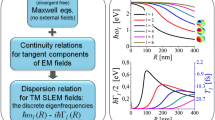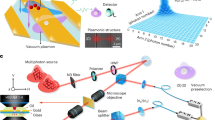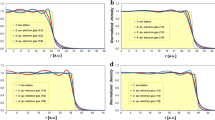Abstract.
We show that the dynamics of the surface plasmon in metallic nanoparticles damped by its interaction with particle-hole excitations can be modelled by a single degree of freedom coupled to an environment. In this approach, the fast decrease of the dipole matrix elements that couple the plasmon to particle-hole pairs with the energy of the excitation allows a separation of the Hilbert space into low- and high-energy subspaces at a characteristic energy that we estimate. A picture of the spectrum consisting of a collective excitation built from low-energy excitations which interacts with high-energy particle-hole states can be formalised. The high-energy excitations yield an approximate description of a dissipative environment (or “bath") within a finite confined system. Estimates for the relevant timescales establish the Markovian character of the bath dynamics with respect to the surface plasmon evolution for nanoparticles with a radius larger than about 1 nm.
Similar content being viewed by others
References
W.A. de Heer, Rev. Mod. Phys. 265, 611 (1993)
M. Brack, Rev. Mod. Phys. 265, 677 (1993)
W.D. Knight, K. Clemenger, W.A. de Heer, W.A. Saunders, M.Y. Chou, Phys. Rev. Lett. 52, 2141 (1984); W.D. Knight, K. Clemenger, W.A. de Heer, W.A. Saunders, Phys. Rev. B 31, 2539 (1985)
M. Brack, R.K. Bhaduri, Semiclassical Physics (Frontiers in Physics, Addison-Wesley, Reading, 1997)
L.G. Gerchikov, C. Guet, A.N. Ipatov, Phys. Rev. A 66, 053202 (2002)
G. Weick, G.-L. Ingold, R.A. Jalabert, D. Weinmann, Phys. Rev. B 74, 165421 (2006)
K. Selby, V. Kresin, J. Masui, M. Vollmer, W.A. de Heer, A. Scheidemann, W.D. Knight, Phys. Rev. B 43, 4565 (1991)
C. Yannouleas, R.A. Broglia, Phys. Rev. A 44, 5793 (1991)
A. Kawabata, R. Kubo, J. Phys. Soc. Jpn 21, 1765 (1966)
M. Barma, V. Subrahmanyam, J. Phys.: Condens. Matter 1, 7681 (1989)
C. Yannouleas, R.A. Broglia, Ann. Phys. (N.Y.) 217, 105 (1992)
R.A. Molina, D. Weinmann, R.A. Jalabert, Phys. Rev. B 65, 155427 (2002); R.A. Molina, D. Weinmann, R.A. Jalabert, Eur. Phys. J. D 24, 127 (2003)
G. Weick, R.A. Molina, D. Weinmann, R.A. Jalabert, Phys. Rev. B 72, 115410 (2005)
J.-Y. Bigot, V. Halté, J.-C. Merle, A. Daunois, Chem. Phys. 251, 181 (2000)
N. Del Fatti, F. Vallée, C. Flytzanis, Y. Hamanaka, A. Nakamura, Chem. Phys. 251, 215 (2000)
B. Lamprecht, J.R. Krenn, A. Leitner, F.R. Aussenegg, Phys. Rev. Lett. 83, 4421 (1999)
Y.-H. Liau, A.N. Unterreiner, Q. Chang, N.F. Scherer, J. Phys. Chem. B 105, 2135 (2001)
G. Weick, D. Weinmann, G.-L. Ingold, R.A. Jalabert, Europhys. Lett. 78, 27002 (2007)
F. Guinea, Phys. Rev. Lett. 53, 1268 (1984)
G. Weick, G.-L. Ingold, D. Weinmann, R.A. Jalabert, Eur. Phys. J. D 44, 359 (2007)
P. Ring, P. Schuck, The Nuclear Many-Body Problem (Springer-Verlag, New York, 1980)
C. Yannouleas, M. Dworzecka, J.J. Griffin, Nucl. Phys. A 379, 256 (1982)
E. Lipparini, S. Stringari, Z. Phys. D 18, 193 (1991)
J. Bapst, P.-G. Reinhard, Z. Phys. D 42, 209 (1997)
Y. Kurzweil, R. Baer, Phys. Rev. B 73, 075413 (2006)
B. Mehlig, K. Richter, Phys. Rev. Lett. 80, 1936 (1997)
F. Guinea, R.A. Jalabert, F. Sols, Phys. Rev. B 70, 085310 (2004)
M. Feingold, A. Peres, Phys. Rev. A 34, 591 (1986)
M. Wilkinson, J. Phys. A 20, 2415 (1987)
B. Eckhardt, S. Fishman, K. Müller, D. Wintgen, Phys. Rev. A 45, 3531 (1992)
Author information
Authors and Affiliations
Corresponding author
Rights and permissions
About this article
Cite this article
Seoanez, C., Weick, G., Jalabert, R. et al. Friction of the surface plasmon by high-energy particle-hole pairs. Eur. Phys. J. D 44, 351–358 (2007). https://doi.org/10.1140/epjd/e2007-00195-4
Received:
Published:
Issue Date:
DOI: https://doi.org/10.1140/epjd/e2007-00195-4




